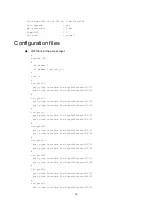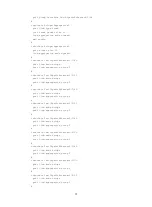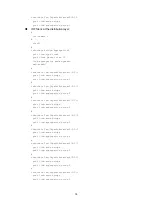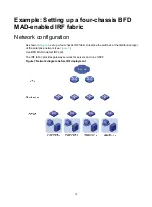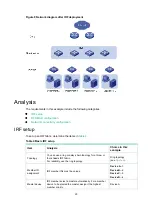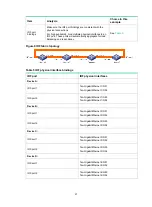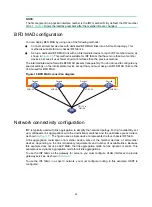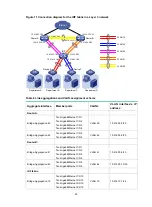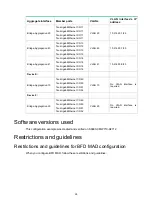
9
[DeviceC] irf-port-configuration active
Device C reboots to join the IRF fabric. A three-chassis IRF fabric is formed.
4.
Configure Device D:
# Assign member ID 4 to Device D, and reboot the device to effect the member ID change.
<DeviceD> system-view
[DeviceD] irf member 1 renumber 4
Renumbering the member ID may result in configuration change or loss. Continue? [Y/N]:y
[DeviceD] quit
<DeviceD> reboot
# Shut down the physical interfaces used for IRF connection. This example uses the port group
that contains Ten-GigabitEthernet 4/0/51 to Ten-GigabitEthernet 4/0/54 for IRF connection.
<DeviceD> system-view
[DeviceD] interface range ten-gigabitethernet 4/0/51 to ten-gigabitethernet 4/0/54
[DeviceD-if-range] shutdown
[DeviceD-if-range] quit
# Bind Ten-GigabitEthernet 4/0/51 and Ten-GigabitEthernet 4/0/52 to IRF-port 4/1.
[DeviceD] irf-port 4/1
[DeviceD-irf-port4/1] port group interface ten-gigabitethernet 4/0/51
[DeviceD-irf-port4/1] port group interface ten-gigabitethernet 4/0/52
[DeviceD-irf-port4/1] quit
# Bind Ten-GigabitEthernet 4/0/53 and Ten-GigabitEthernet 4/0/54 to IRF-port 4/2.
[DeviceD] irf-port 4/2
[DeviceD-irf-port4/2] port group interface ten-gigabitethernet 4/0/53
[DeviceD-irf-port4/2] port group interface ten-gigabitethernet 4/0/54
[DeviceD-irf-port4/2] quit
# Bring up the physical interfaces.
[DeviceD] interface range ten-gigabitethernet 4/0/51 to ten-gigabitethernet 4/0/54
[DeviceD-if-range] undo shutdown
[DeviceD-if-range] quit
# Save the running configuration.
[DeviceD] quit
<DeviceD> save
# Connect Device D to Device A and Device C, as shown in
# Activate the IRF port configuration.
<DeviceD> system-view
[DeviceD] irf-port-configuration active
Device D reboots to join the IRF fabric. A four-chassis IRF fabric is formed. The command
prompt changes to the name of Device A (the master).
5.
Change the name of the IRF fabric.
<DeviceA> system-view
[DeviceA] sysname IRF
[IRF]
Configuring LACP MAD
1.
Configure the IRF fabric at the access layer:
# Assign domain ID 1 to the IRF fabric.


















